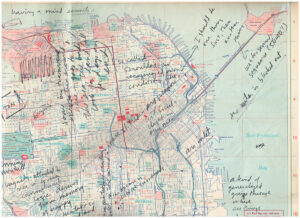MATERIAL TRANSMISSIONS:
DEMOTIC SURREALISM/HIERATIC LANGUAGE,
SAN FRANCISCO, 1975–1980
Plunged each day into the fog of received ideas, man is led to conceive
of all things and to conceive of himself through a dizzy series of quickly
hidden stumblings, of false steps rectified as best as possible.
—André Breton, “The Automatic Message” (1933)
The 1970s witnessed the contact of two avant-garde poetry movements in the artistic milieu of countercultural San Francisco: surrealism, in its fifth decade of global influence, and Language writing, in the first decade of emergence. The two movements were separated not only temporally but geographically: surrealist influence, active in San Francisco since the 1940s, disseminated in the visual arts around the San Francisco Art Institute, while its literary complement centered around North Beach reading series and publication venues, especially City Lights Books, which claimed surrealism as a founding influence on the Beats. Language writing, on the other hand, arose in alternative artist spaces and reading series in South of Market and the Haight-Ashbury, especially 80 Langton Street and the Grand Piano. Numerous surrealist poets were active in the period: Philip Lamantia, Harold Norse, Bob Kaufman, Nanos Valaoritis, Sortere Torregian, and Helen Adam, while surrealism was a hybrid legacy in the work of Robert Duncan and Jack Spicer (even as the New American Poetry tended to downplay surrealism’s influence). San Francisco Language writers Steve Benson, Alan Bernheimer, Carla Harryman, Kit Robinson, and I embraced surrealism to a measured extent while making a clear break from its authorial immanence in our turn to language-centered writing. Others, like Ron Silliman and Lyn Hejinian, preserved a skepticism toward its romantic and totalizing claims while absorbing its formal devices in their more materialist aesthetics. Finally, poets influenced by objectivism or the post-surrealist OuLiPo felt little obligation to valorize its subjective methods. This essay locates the influence and/or rejection of surrealism on Language writing, tracking a dialectic between a “hieratic” surrealism focused on continuing the “automatic message” from a “demotic” surrealism pursuing a revolutionary poetics of la beauté est dans la rue, a legacy of May 68 in post-Vietnam America. This hieratic/demotic dialectic, my argument pursues, may also be found in Language writing: its materially generated automatism; poetic forms of poésie ininterrompue; a group methodology; and a collective politics all are manifested in the “turn to language” in poetry. At the same time, Language writing had a stake in everyday life, from the working-class zones it frequented to its preference for a micropolitics of petite histoire as opposed to the Bretonian “Great Invisibles.” The tension between the two groups in this period worked to create a faultline across geography and modes of living, from the fixtures of bohemia in North Beach to alternative artist spaces South of Market. This geographical disconnect persisted as an imagined rivalry into the 80s and beyond. [. . .]
Notes
The paragraph above opens my contribution to the recent conference of the International Society for the Study of Surrealism, Houston, 12 November 2023, on a panel with Lauri Scheyer, Christopher Winks, and Carla Harryman.
Illustration: drawing by the author, c. 1973, on Arco Gasoline map of San Francisco. The “automatic” overwriting of the map resulted in the following, published in Opera—Works (Bolinas, Calif.: Big Sky Books, 1975), pp. 26—27.
LIVING SPACE
Artificial light
light in area
area—a district
ocean surrounds a district
the water is blacked out
a space of trees level in wind
against the black illustration
background of one thing
many motions of caution
generalized guise through which
no prior registration
wish for sound sequence
( )
having a mind sensate
reduced to simple terms
vaguely attached to former logic
places, numbers, squares, streets
while running downhill
the way hills go
a clear day as seen from the air
the sea, the birds look for landfall
days on end
the edge of the world
gauze curtained—
visual indifference is growth













